The AMD Threadripper 2990WX 32-Core and 2950X 16-Core Review
by Dr. Ian Cutress on August 13, 2018 9:00 AM ESTHEDT Benchmarks: Rendering Tests
Rendering is often a key target for processor workloads, lending itself to a professional environment. It comes in different formats as well, from 3D rendering through rasterization, such as games, or by ray tracing, and invokes the ability of the software to manage meshes, textures, collisions, aliasing, physics (in animations), and discarding unnecessary work. Most renderers offer CPU code paths, while a few use GPUs and select environments use FPGAs or dedicated ASICs. For big studios however, CPUs are still the hardware of choice.
Corona 1.3: Performance Render
An advanced performance based renderer for software such as 3ds Max and Cinema 4D, the Corona benchmark renders a generated scene as a standard under its 1.3 software version. Normally the GUI implementation of the benchmark shows the scene being built, and allows the user to upload the result as a ‘time to complete’.
We got in contact with the developer who gave us a command line version of the benchmark that does a direct output of results. Rather than reporting time, we report the average number of rays per second across six runs, as the performance scaling of a result per unit time is typically visually easier to understand.
The Corona benchmark website can be found at https://corona-renderer.com/benchmark
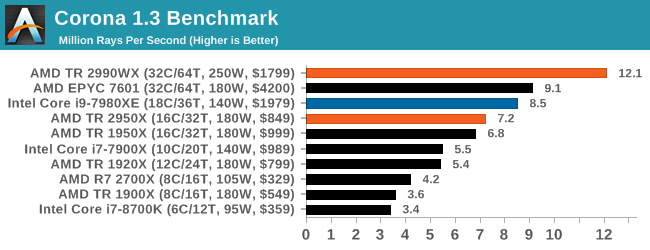
So this is where AMD broke our graphing engine. Because we report Corona in rays per second, having 12 million of them puts eight digits into our engine, which it then tries to interpret as a scientific number (1.2 x 10^7), which it can’t process in a graph. We had to convert this graph into millions of rays per second to get it to work.
The 2990WX hits out in front with 32 cores, with its higher frequency being the main reason it is so far ahead of the EPYC processor. The EPYC and Core i9 are close together, however the TR2950X at half the cost comes reasonably close.
Blender 2.79b: 3D Creation Suite
A high profile rendering tool, Blender is open-source allowing for massive amounts of configurability, and is used by a number of high-profile animation studios worldwide. The organization recently released a Blender benchmark package, a couple of weeks after we had narrowed our Blender test for our new suite, however their test can take over an hour. For our results, we run one of the sub-tests in that suite through the command line - a standard ‘bmw27’ scene in CPU only mode, and measure the time to complete the render.
Blender can be downloaded at https://www.blender.org/download/
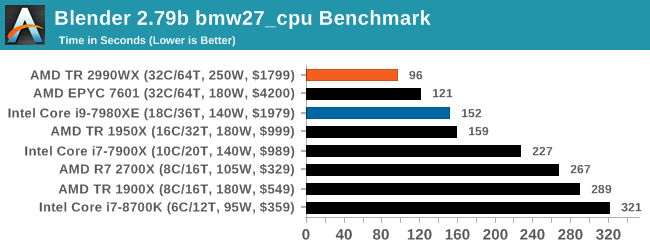
The additional cores on the 2990WX puts it out ahead of the EPYC and Core i9, with the 2990WX having an extra 58% throughput over the Core i9. That is very substantial indeed.
LuxMark v3.1: LuxRender via Different Code Paths
As stated at the top, there are many different ways to process rendering data: CPU, GPU, Accelerator, and others. On top of that, there are many frameworks and APIs in which to program, depending on how the software will be used. LuxMark, a benchmark developed using the LuxRender engine, offers several different scenes and APIs.

Taken from the Linux Version of LuxMark
In our test, we run the simple ‘Ball’ scene on both the C++ and OpenCL code paths, but in CPU mode. This scene starts with a rough render and slowly improves the quality over two minutes, giving a final result in what is essentially an average ‘kilorays per second’.
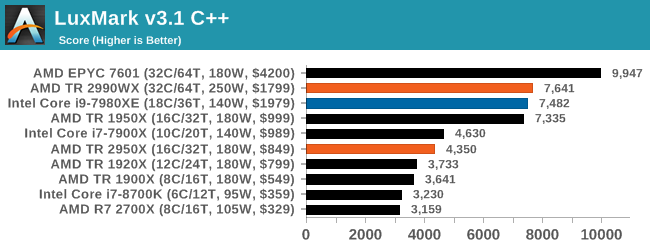
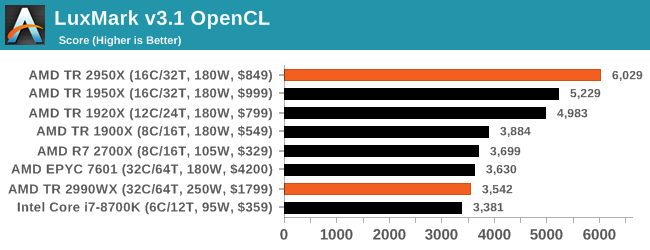
Intel’s Skylake-X processors seem to fail our OpenCL test for some reason, but in the C++ test the extra memory controllers on EPYC sets it ahead of both TR2 and Core i9. The 2990WX and Core i9 are almost equal here.
POV-Ray 3.7.1: Ray Tracing
The Persistence of Vision ray tracing engine is another well-known benchmarking tool, which was in a state of relative hibernation until AMD released its Zen processors, to which suddenly both Intel and AMD were submitting code to the main branch of the open source project. For our test, we use the built-in benchmark for all-cores, called from the command line.
POV-Ray can be downloaded from http://www.povray.org/
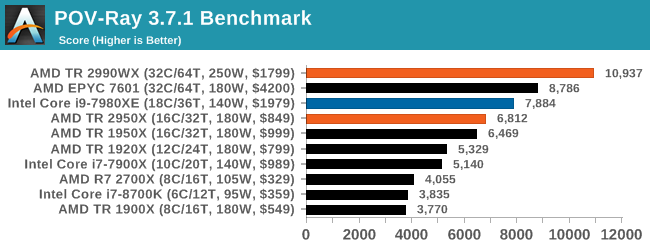
This test is another that loves the cores and frequency of the 2990WX, finishing the benchmark in almost 20 seconds. It might be time for a bigger built-in benchmark.


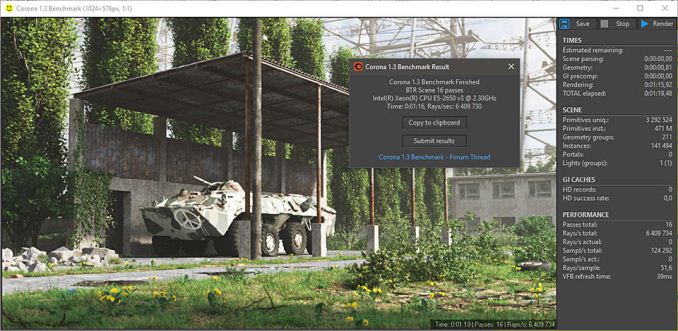








171 Comments
View All Comments
edzieba - Monday, August 13, 2018 - link
Not really. In chasing Moar Cores you only excel in embarrassingly parallel workloads. And embarrassingly parallel workloads are in GPGPU's house. And GPU lives in GPGPU's house.boeush - Monday, August 13, 2018 - link
Try to run multiple VMs/Containers and/or multiple desktop sessions on a GPGPU: you might find out that GPGPU's house isn't all it's cracked up to be...SonicKrunch - Monday, August 13, 2018 - link
Look at that power consumption. I'm not suggesting AMD didn't create a really great CPU here, but they really need to work on their efficiency. It's always been their problem, and it's not seemingly going away. The market for these near 2k chips is also not huge in comparison to normal desktop space. Intel has plenty of time to answer here with their known efficiency.The_Assimilator - Monday, August 13, 2018 - link
Yeah... look at the number of cores, numpty.somejerkwad - Monday, August 13, 2018 - link
The same efficiency that has consumer-grade products operating on more electricity in per-core and per-clock comparisons? Overclocking power gets really silly on Intel's high end offerings too, if you care to look at the numbers people are getting with an i9 that has fewer cores.eddman - Monday, August 13, 2018 - link
Interesting, can you post a link, please? I've read a few reviews here and there and when comparing 2600x to 8700k (which is more or less fair), it seems in most cases 8700k consumes less energy, even though it has higher boost clocks.CrazyElf - Monday, August 13, 2018 - link
The 8700k is not the problem. It is Skylake X.https://www.tomshardware.com/reviews/-intel-skylak...
Power consumption when you OC X299 scales up quickly. Threadripper is not an 8700k competitor. It is an X299 competitor. The 32 core AMD is clearly priced to compete against the 7980X, unless Intel cuts the price.
eddman - Tuesday, August 14, 2018 - link
I should've made it clear. I was replying to the "more electricity in per-core and per-clock" part. Also, he wrote consumer-grade, which is not HEDT. I do know that TR competes with SKL-X.Comparing OCing power consumption is rather pointless when one chip is able to clock much higher.
Even when comparing 2950 to 7980, there are a lot of instances where 7980 consumes about the same power or even less. I don't see how ryzen is more efficient.
alpha754293 - Monday, August 13, 2018 - link
@ibnmadhi"It's over, Intel is finished."
Hardly.
For example, the Threadripper 2990WX (32C, 3.0 GHz) gets the highest score in POV-Ray 3.7.1 benchmark, but when you compute the efficiency, it's actually the worst for it.
It consumes more power and only gets about 114 points per (base clock * # of cores - which is a way to roughly estimate the CPU's total processing capability).
By comparison, the Intel Core i9-7980XE (18C, 2.6 GHz) is actually the MOST EFFICIENT at 168 points per (base clock * # of cores). It consumes less power than the Threadripper processors, but it does also cost more.
If I can get a system that can do as much or more for less, both in terms of capital cost and running cost (i.e. total cost of ownership), then why would I want to go AMD?
I use to run all AMD when it was a better value proposition and when Intel's power profile was much worse than AMD's. Now, it has completely flipped around.
Keep also in mind, that they kept the Epyc 7601 processor in here for comparison, a processor that costs $4200 each.
At that price, I know that I can get an Intel Xeon processor, with about the same core count and base clock speed for about the same price, but I also know that it will outperform the Epyc 7601 as well when you look at the data.
As of August, 2018, Intel has a commanding 79.4% market share compared to AMD's 20.6%. That's FARRR from Intel being over.
ender8282 - Monday, August 13, 2018 - link
base clock * number of cores seems like a poor stand in for performance per watt. If we assume that IPC and other factors like mem/cache latency are the same then sure base clock * num cores effectively gives us performance unit of power but we know those are not constant.